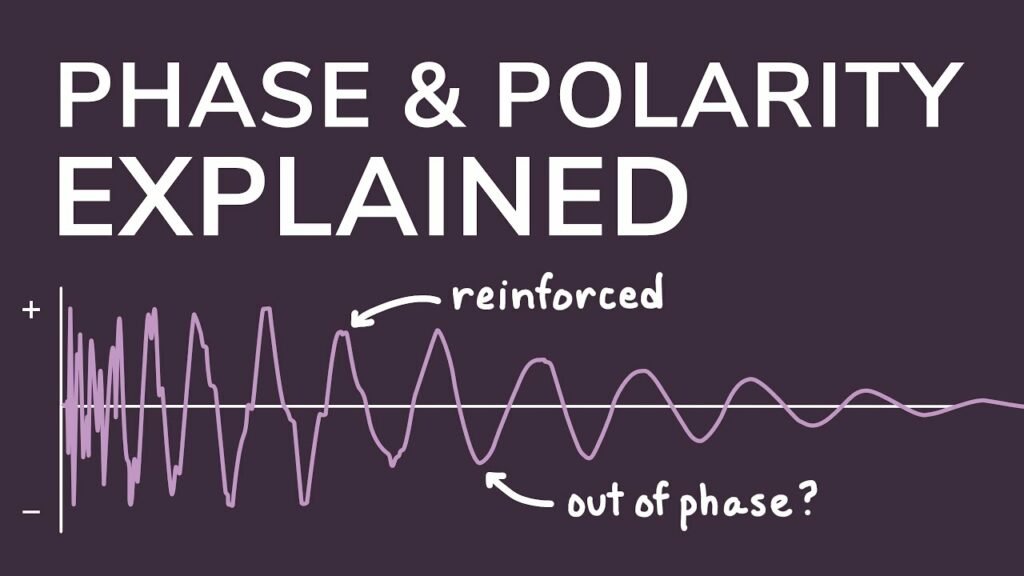
i ’m going to be showing you the differences between both of them and why they ’re important for your music product mixing or learning also we ’re going to look at some practical exemplifications so that you can hear the difference and also find some ways to correct opposition or phase issues in your blend so let’s get right into it let’s just start with a simple description so what's opposition well any electrical or audio signal has opposition and it’s simply a reference to the signal’s position or voltage above or below this central median line but what does this mean for actually creating sound in this simple sine surge illustration the speaker or headphone diaphragm is trying to follow this wind so whenever it goes positive it’s trying to push air out towards you and when it goes negative it’s trying to pull the speaker or headphone diaphragm backwards let’s now rear or reverse the opposition of this waveform and you ’ll see that all the positive values come negative and the negative values come positive so where you ’re substantially going to hear a difference is at the launch of this sample where rather of the waveform
pushing the speaker out it’s actually pulling the speaker back in while opposition can be defined with just one waveform we really need two or further signals to start talking about phase rather veritably analogous signals similar as an microphones these two signals are in phase they start at the same time and you can see that their oppositeness match so these two waveforms will add together to support and produce a stronger bigger sound but if i delay one of the signals which could do from a recording editing or indeed outfit error we'd relate to these waveforms as being out of phase and in this illustration because their oppositeness are contrary they will cancel out and you'll end up with no sound at each it gets a little confusing if i reverse the opposition of the nethermost sample you can see these two waveforms will now add up to produce a stronger sample and they appear to be in phase but when we ’re talking about opposition i ’m talking about changing the state around that median line so flipping the sample like this and when talking about phase we mean samples not lining up duly due to some kind of recording mixing editing or indeed outfit error musical waveforms are infrequently as simple as that first illustration so with two more complex waveforms we can again draw that central median line we can
observe their opposition where the waveforms go over and below this line and if you do n’t pay attention to opposition and phase frequently sounds can add together and have phase cancellation which we can visibly see then these two samples added together to lower and weaker sample than before still if we ’re careful and we do consider the opposition and the phase relationship of different signals we can insure that when they add together that they support each other and produce a stronger and further musical sound i would noway give rules for mixing and learning but i want to offer some suggestions which might help with phase and opposition issues and the first is to be careful with multi mic recording anytime you use further than one microphone you open yourself up to all feathers of phase issues spending a many further twinkles and getting it right at the source can save you so important work latterly on another
thing to consider is that criticizing can frequently hide phase and opposition problems so as i ’ve mentioned in the once sometimes check your blend in mono to see if it reveals any of these issues to you you might also consider whether you ’re over using imaging or stereo widening plugins these sound great and they surely have a place in mixing but overuse of these plugins frequently causes phase issues and you can lose a lot of integrity in the audio signal and while i suppose you should always use your cognizance to identify and fix these problems you could consider using a free correlation cadence which i ’ll show you in just a moment to check visually if you do n’t have an ideal monitoring terrain so now i ’m going to turn my camera on and we ’re going to get to some practical exemplifications in this case i ’m using fl plant but it does n’t matter which software you use they all have the same features and functions and i ’m working with some waveform audio but this is just as important whether you ’re using midi or you ’ve recorded stuff or you ’re working from sample packs so anyway i've this barrel circle that i ’m working with it sounds good but i do n’t like the low end of the kick barrel i feel that it’s too thin
so i decided to support it with a alternate kick barrel now unfortunately when these two samples add together they start to cancel each other out if i reverse the opposition (Music) it’s such a huge difference and for anyone who’s floundering to hear it depending on your system your headphones what we ’re harkening for are these feathers of frequentness then we ’re really just honing in on those low subby frequentness let’s do a quick ahead and later and also look at the cadence then the diapason to see all that extra low end energy being added when i reverse the opposition (Music) when i zoom in on the samples it becomes much further apparent why reversing the opposition in this case makes it so much louder so if we look at the kick barrel on the barrel circle then it’s in red and our sample then we can see that as the barrel circle kick goes up the sample is actually going down and they ’re nearly fully out of phase with each other their opposition is contrary so if i take the kick barrel on the bottom
and i just reverse the opposition we can see that now as one sample goes up so does the other and they tend to support each other but i do want to point out that this is n’t perfect and i still will be creating other phase issues while i'll be making some of the opposition have a better relationship i'll also be intruding up other areas but if i show you some exemplifications that i prepared before without the opposition reversal those two kick cans add up to look like this it sounds like this which is what we were hearing earlier relatively weak not a lot of low end with the opposition reversal it sounds like this just an awful lot more low end surely buttressing each other it’s also important to consider the flash the launch of the sample because that’s generally particularly important when you ’re dealing with cans so just make sure that you ’re checking the phase relationship or the opposition at the launch of the sample as well as during the middle of the sample now we used our cognizance for this illustration we did n’t really have to zoom in on the waveform to hear that massive problem but there are a many tools you can use to help you out with this so the first was this diapason analyzer i showed then gauge it happens to have a correlation cadence so in your daw you probably have a tool called a correlation cadence or a phase correlation cadence and there’s another free one down then called msed
it’s a little further simple because it does n’t have the big diapason on it as well this lets you see the opposition relationship between the left and right channels so if one channel is trying to push the speakers out and the other channels pulling it back in one’s positive one’s negative at a certain moment in time this is going to let you see this so it starts at zero and values above indicate a good phase relationship or opposition relationship and values below indicate that we've a bad relationship now these figures one zero disadvantage bone they ’re not arbitrary and i ’ve put some information in the description talking about the fine evidence of that for anyone that’s interested unfortunately this tool does n’t really help with mono signals because if i play this barrel circle and kick with a bad opposition relationship it’s





